When it’s time to celebrate, many of us reach for a glass of bubbly and call it “Champagne.” But here’s the secret every wine enthusiast knows: all Champagne is sparkling wine, but not all sparkling wine is Champagne.
So what makes Champagne so special—and why doesn’t every bottle with bubbles qualify?
Let’s pop the cork on the truth and uncover what really separates Champagne from other sparkling wines like Prosecco, Cava, Crémant, and Sekt.
🥇 Champagne is a Protected Name
Champagne is not just a style of wine—it’s a region in northeastern France. According to French and international law, only sparkling wines made in this specific region under strict rules can legally be called “Champagne.”
This concept is known as Appellation d’Origine Contrôlée (AOC)—a legal framework that protects traditional products made in specific regions (like Champagne, Roquefort cheese, or Bordeaux wine).
🛠️ The Champagne Method (Méthode Champenoise)
What makes Champagne even more unique is how it’s made:
-
Primary Fermentation – Creates a still wine.
-
Blending (Assemblage) – Often combines multiple vintages and grape varieties.
-
Secondary Fermentation in the Bottle – Yeast and sugar are added before sealing, creating CO₂ (the bubbles).
-
Aging on Lees – The wine ages with dead yeast cells for a complex, creamy texture.
-
Riddling & Disgorgement – The sediment is removed before final corking.
This time-consuming process is called Méthode Traditionnelle (or Méthode Champenoise in Champagne) and is essential to the character of true Champagne.
🍇 Which Grapes are Used in Champagne?
Only a few grapes are allowed in true Champagne production:
-
Chardonnay – for elegance and acidity
-
Pinot Noir – adds body and structure
-
Pinot Meunier – brings fruitiness and roundness
🌍 So, What Is Sparkling Wine Then?
“Sparkling wine” is a broad term for any wine with bubbles, made anywhere in the world, and using various methods. Some of the most popular types include:
-
Prosecco – Italy
Made using the tank (Charmat) method; lighter and fruitier. -
Cava – Spain
Made using the traditional method like Champagne, but aged less. -
Crémant – France (outside Champagne)
Often made with similar grapes and method but from regions like Alsace or Loire. -
Sekt – Germany
Typically lighter in alcohol and sweeter, often made from Riesling grapes. -
American Sparkling Wine – California, Oregon, New York
Can be made using any method, with wide variation in quality.
⚖️ Champagne vs Sparkling Wine: What’s the Real Difference?
| Feature | Champagne | Sparkling Wine (General) |
|---|---|---|
| Origin | Champagne, France | Global (Italy, Spain, USA, etc.) |
| Method of Production | Méthode Champenoise (Traditional) | Varies: traditional or tank |
| Aging Requirements | Min. 15 months (non-vintage) | Varies; Prosecco has no aging |
| Taste & Texture | Complex, creamy, nutty | Fruity, floral, fresh |
| Price Range | Premium to luxury | Affordable to premium |
| Legal Protection | Yes, AOC-controlled | No legal restriction |
🍾 Why Champagne is More Expensive
A bottle of true Champagne often costs more because:
-
The production process is more labor-intensive.
-
It’s aged longer.
-
Grapes are grown in limited terroirs.
-
It’s a protected brand with global prestige.
You’re not just paying for bubbles—you’re paying for tradition, time, and terroir.
🧠 Fun Fact: Not All Champagne is White
-
Blanc de Blancs: Made only from Chardonnay.
-
Blanc de Noirs: Made from Pinot Noir/Meunier, but appears white.
-
Rosé Champagne: Made by blending or skin contact.
🍽️ Food Pairing: Champagne vs Other Sparkling Wines
| Wine Type | Best Food Pairings |
|---|---|
| Champagne | Oysters, caviar, fried chicken, truffle popcorn |
| Prosecco | Prosciutto, melon, light salads, sushi |
| Cava | Tapas, cheese, Spanish omelet, shellfish |
| Sparkling Rosé | Smoked salmon, soft cheeses, berries |
Champagne is incredibly food-friendly—its acidity and fine bubbles cut through rich, fatty foods beautifully.
🥂 How to Spot a Real Champagne
To make sure you’re getting authentic Champagne, check for:
-
Label that says “Champagne”
-
Producer located in France’s Champagne region
-
AOC seal or reference
-
Vintage or non-vintage indication
-
Méthode Traditionnelle mentioned
If it says “sparkling wine” but not “Champagne,” it’s probably from another region, even if it’s made in the same style.
🏁 Final Sip: Bubbles with Identity
To recap:
-
All Champagne is a type of sparkling wine.
-
But most sparkling wines are not Champagne—they may be Prosecco, Cava, Crémant, or others.
-
Champagne is a symbol of luxury and tradition with global recognition.
-
Sparkling wines worldwide offer amazing variety and value.
So, next time you reach for a bubbly bottle, check the label and toast with intention. Whether it’s a celebratory Champagne or a casual Prosecco, there’s a story behind every sparkle.





